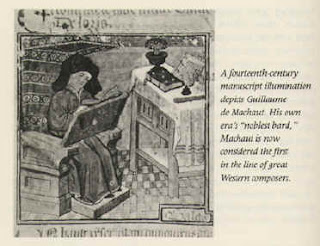Lindsay Lozito
351 WI
Dr. Granade
September 24, 2009
Journal Response to Brett’s: Cantigas de Santa Maria
Many people, including myself, have had false perceptions of the medieval period. We are quick to jump to conclusions on how music of the medieval period might be boring and pointless, but what we forget to remember is that music today is derived from music of the past, including the medieval period. From music, we are able to capture certain emotions in hopes of portraying that emotion to our audience. Medieval music has did this. I was very intrigued after reading through Brett’s journal about the Cantigas de Santa Maria. At the beginning of his journal he describes the piece as he understands it, but also points out some parallel relations to Puccini in the romantic period. Brett mentions how similar the two styles are with the parallel motion between the voices and the instruments. I thought Brett could have expanded more on the ideas of how both the Cantigas de Santa Maria and Puccini’s style of the romantic era are similar and how they are different. This just goes to show how music we know and enjoy, such as Puccini’s works, can relate to the medieval time period.
After reading through Brett’s journal of the Cantigas de Santa Maria, I became fascinated when listening to the work. Not being very knowledgeable about the piece, I was able to understand the meaning of the piece. Brett gave a clear description of each section of the piece, including different instruments used in the piece, and how it related to the actual text. It is especially apparent that Brett understands the terminology of the medieval time in how he tells us where we can find the certain style or idea in the music. Along with supplying good descriptions of the terminology, he uses the names of specific movements in the piece to show exactly how each term is applied in the music.
I was pleased to see Brett point out how the music is exceedingly interpretive and how the text is used to guide a particular emotion. This helps us to relate the music we play today with how it was developed. As much as I was fascinated by Brett’s descriptions of the entire piece and its movements, I was disappointed not to see more of Brett’s opinion about the piece. At the beginning of his journal, Brett states that he had heard much about the Cantigas de Santa Maria in the past, and was excited to delve into the piece to help him better understand the contents of the piece. It is great the he found out more information about the piece in its entirety, but I am curious to know his opinion of the piece after the extensive research he did.
Overall Brett did a fantastic job with his journal entry. His fluidity of writing made it easy to follow and understand exactly what is happening in the piece. The description of each movement aided me when listening to the piece, because it helped me to recognize most of the subjects Brett discussed in his journal entry. I especially enjoyed how Brett took the time to discuss all the instruments found in the piece and describe exactly where each instrument comes into play. Furthermore, he discusses the interplay between the instruments and the voice part. Brett has great organizational skills and a flowing paper, which helped make his journal more appealing to read. Brett is correct in saying that if only people would take the time to learn about medieval music, they would recognize the similarities in what we hear in today’s music. Our past helps shape our future in all aspects of life, especially music.


